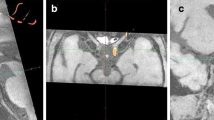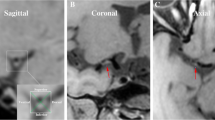Abstract
Introduction
In this study, we investigated whether pre-procedural imaging of LSAs would potentially be helpful for preventing LSAs from being covered.
Methods
We retrospectively evaluated the LSAs of 15 consecutive patients who underwent revascularization for symptomatic middle cerebral artery (MCA) stenosis. All patients underwent two- (2D) and three-dimensional (3D) digital subtraction angiography.
Results
We found that 46.7 (7/15), 40 (6/15), and 13.3 % (2/15) of patients had stenotic lesions in the proximal, middle, and distal third of the M1 segment, respectively. There was a total of 32 LSAs that originated from the lesioned MCAs. Seven (21.9 %), 10 (31.3 %), 11 (34.4 %), and 4 (12.5 %) LSAs originated from the proximal third of the M1 segment, middle third of the M1 segment, distal third of the M1 segment, and starting segment of the superior M2 segment, respectively. Sixteen (76.2 %) of 22 LSAs in 13 patients were covered by stents. It would have been possible to avoid covering 43.8 % (7/16) of these LSAs with stents if they had been evaluated before stenting, and the stents had been accurately deployed. Among 16 LSAs which were covered by stent, only one (6.25 %) was occluded after coverage.
Conclusion
Our data suggest that evaluation of LSAs during MCA stenting would be potentially helpful for preventing LSAs from being covered and subsequently occluded by stents.





Similar content being viewed by others
References
Jiang WJ, Srivastava T, Gao F, Du B, Dong KH, Xu XT (2006) Perforator stroke after elective stenting of symptomatic intracranial stenosis. Neurology 66:1868–1872
Kole M, Amin B, Marin H, Russman A, Sanders W (2009) Intracranial angioplasty and stent placement for direct cerebral revascularization of nonacute intracranial occlusions and near occlusions. Neurosurg Focus 26:E3
Levy EI, Chaturvedi S (2006) Perforator stroke following intracranial stenting: a sacrifice for the greater good? Neurology 66:1803–1804
Cho ZH, Kang CK, Han JY, Kim SH, Kim KN, Hong SM (2008) Observation of the lenticulostriate arteries in the human brain in vivo using 7.0 T MR angiography. Stroke 39:1604–1606
Hendrikse J, Zwanenburg JJ, Visser F, Takahara T, Luijten P (2008) Noninvasive depiction of the lenticulostriate arteries with time-of-flight MR angiography at 7.0 T. Cerebrovasc Dis (Dasel, Switzerland) 26:624–629
Kang HS, Han MH, Kwon BJ, Kwon OK, Kim SH, Chang KH (2005) Evaluation of the lenticulostriate arteries with rotational angiography and 3D reconstruction. AJNR Am J Neuroradiol 26:306–312
Schumacher HC, Meyers PM, Higashida RT, Derdeyn CP, Lavine SD, Nesbit GM et al (2009) Reporting standards for angioplasty and stent-assisted angioplasty for intracranial atherosclerosis. Stroke 40:e348–e365
Samuels OB, Joseph GJ, Lynn MJ, Smith HA, Chimowitz MI (2000) A standardized method for measuring intracranial arterial stenosis. AJNR Am J Neuroradiol 21:643–646
Mori T, Fukuoka M, Kazita K, Mori K (1998) Follow-up study after intracranial percutaneous transluminal cerebral balloon angioplasty. AJNR Am J Neuroradiol 19:1525–1533
Mori T, Mori K, Fukuoka M, Arisawa M, Honda S (1997) Percutaneous transluminal cerebral angioplasty: serial angiographic follow-up after successful dilatation. Neuroradiology 39:111–116
Kulcsár Z, Ernemann U, Wetzel SG, Bock A, Goericke S, Panagiotopoulos V et al (2010) High-profile flow diverter (silk) implantation in the basilar artery: efficacy in the treatment of aneurysms and the role of the perforators. Stroke 41:1690–1696
Kurre W, Brassel F, Brüning R, Buhk J, Eckert B, Horner S, INTRASTENT study group et al (2012) Complication rates using balloon-expandable and self-expanding stents for the treatment of intracranial atherosclerotic stenoses: analysis of the INTRASTENT multicentric registry. Neuroradiology 54:43–50
Chimowitz MI, Lynn MJ, Derdeyn CP, Turan TN, Fiorella D, Lane BF et al (2011) Stenting versus aggressive medical therapy for intracranial arterial stenosis. N Engl J Med 365:993–1003
Rothwell PM, Eliasziw M, Gutnikov SA, Warlow CP, Barnett HJ, Carotid Endarterectomy Trialists Collaboration (2004) Endarterectomy for symptomatic carotid stenosis in relation to clinical subgroups and timing of surgery. Lancet 363:915–924
Acknowledgments
This work was supported by grants from the National Natural Science Foundation of China (No. 30600193 and 81070914 to J.R. Liu) and a grant from the “New One Hundred Talents Program” from the Shanghai Jiao Tong University School of Medicine (2012, J.R. Liu).
Conflict of interest
We declare that we have no conflict of interest.
Author information
Authors and Affiliations
Corresponding author
Rights and permissions
About this article
Cite this article
Liu, JR., Zhang, M. & Wei, ML. Value of imaging lenticulostriate arteries before middle cerebral artery stenting for the prevention of perforator stroke. Neuroradiology 55, 57–64 (2013). https://doi.org/10.1007/s00234-012-1064-2
Received:
Accepted:
Published:
Issue Date:
DOI: https://doi.org/10.1007/s00234-012-1064-2




